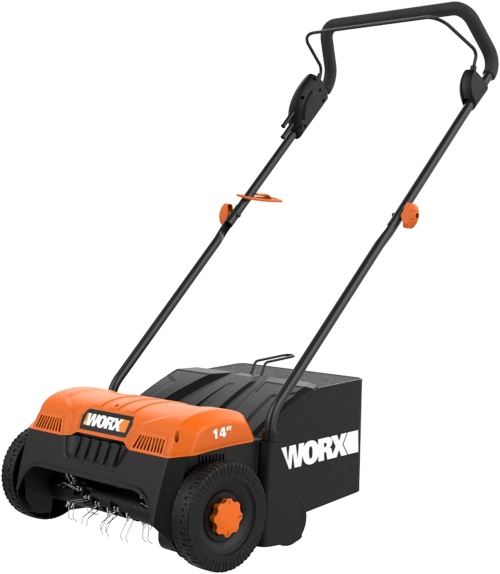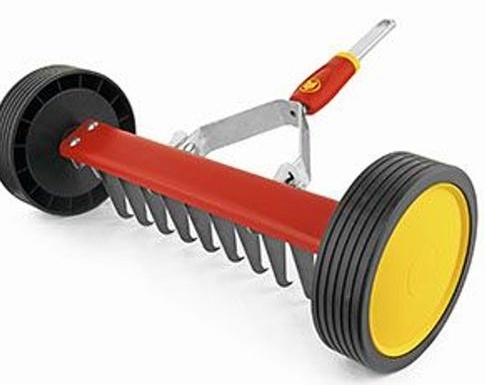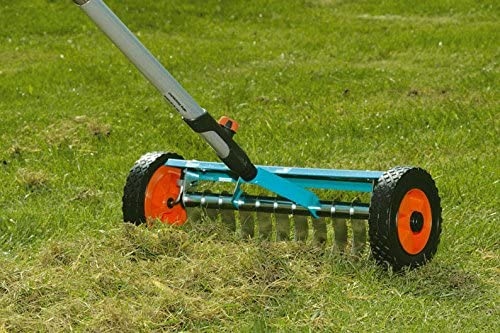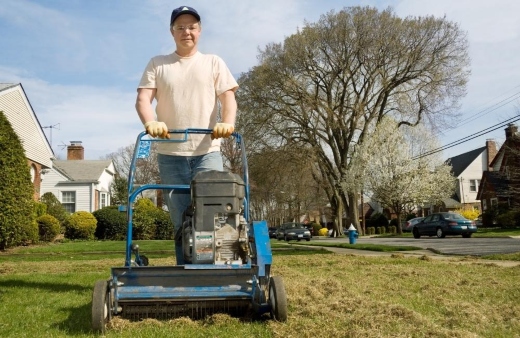Lawn dethatchers are key to maintaining a healthy lawn in modern-day Australia. Lawns are getting harder and harder to maintain as climate change merges together and intensifies our seasons, but keeping lawns green and healthy isn’t just a modern-day challenge.
For centuries, perfect lawns have been symbols of status, and gardening prowess, and today, our lawns are often the first impression of our homes. In this article we’re going to share our thoughts on lawn dethatching; how and when to dethatch, and the best lawn dethatchers in 2025.
More...
Top Pick


Best Value


Best Lawn Dethatchers Ratings Chart
Product | Our Rating | Price | |
|---|---|---|---|
1. WORX WG850 14 Inch Corded Electric Dethatcher |  |  | |
2. WOLF-Garten Multi-Star 35cm wide Scarifying Roller Rake |  |  | |
3. Greenworks Tools 40V Scarifier |  |
Lawn Dethatchers Buyers' Guide

What are Lawn Dethatchers?
Lawn dethatchers are essentially just sprung rakes, designed to pull old growth away from healthy stems on the under-layer of your lawn. In this article, we’ll explore the different types of lawn dethatchers, when to use them, and how to time dethatching most effectively.
What is Lawn Thatch?
Lawn thatch is a layer of dead grass formed as old grass dies back to be replaced by new grass leaves. While it is commonly thought that thatch is a build-up of moss and grass clippings, it is in fact the older stems that die back through summer, winter and autumn to be replaced by new leaves and grass stems in summer.
Thatch is a natural part of grass growth and it occurs on all plants. Similar plants include Peace Lilies, which die back at their base and replace old stems with new.
Larger grasses are easier to dethatch as it’s a simple process of running your hands through old growth in spring to pull it away and make room for new leaves.
Thatch in lawns becomes a problem when lawns are under-fertilised and lawns begin to brown off as thatch outnumbers fresh growth.
Types of Lawn Dethatchers
There are three main types of lawn dethatcher. Two are fairly gentle, with one only really advised for very, very, tough jobs:
- Lawn dethatcher rake
- Rotary dethatcher
- Lawn scarifier

Lawn Thatching Rakes
Lawn thatching rakes are the best dethatching tool for small lawns, with no emissions of energy output. They are a higher effort on the part of the gardener but will save you space, and money, in the process.
For small areas of moss, you can buy small hand rakes to dethatch problem patches that can form under the shade of large trees, or where drainage is a problem, without having to go over the whole lawn.
Lawn Scarifiers
Lawn scarifiers are the most aggressive way to dethatch a lawn, but can be very effective at aerating your topsoil and vastly opening the space for new grass to grow.
Lawn scarifiers are not advised for regular use as they have a noticeable impact on your lawn and can create lines that look over cultivated, but if thatch and moss have become a significant problem, they are the only option.
Rotary Dethatchers
Rotary dethatchers are sold as petrol, diesel, or electric machines, just like lawnmowers, and are less aggressive than scarifiers. For annual use, or bi-annual use rotary dethatcher are the best tool.
It can providing enough aeration for a healthy lawn, and effectively removing young moss and old thatch with minimal effort, and as little damage to your lawn as possible.


Get Your Free Guide:
Master Growing Australian Natives eBook
A Must Have Complete Guide for Every Australian Garden
Get Your Free Guide:
Master Growing Australian Natives eBook
A Must Have Complete Guide for Every Australian Garden
How to Use a Lawn Dethatcher and Lawn Scarifier
Irrigation, lawn mowers, and fertilisers are all key to keeping our lawns looking lush and healthy, but our Australian climate demands a little more care and attention than those typical tools.
Lawn dethatchers are key to that maintenance, but it’s crucial to know how and, more importantly, when, to use them:

Using a Dethatcher to Remove Thatch
Machine dethatchers are the most effective types of dethatcher, able to quickly work through large lawns much faster than thatching rakes or other hand tools, but any dethatcher uses the same basic method:
- Mow your lawn a day or two before dethatching to prevent tears to grass stems. Grass is quick to recover from damage, but a crisp cut will prevent yellowing after dethatching.
- Remove dropped leaves from your lawn (not essential, but it helps with efficiency, and prevent clogging for machine dethatchers).
- Work across your lawn in one direction, working in strips the width of your rake of machine dethatcher.
- Work back in the opposite direction once you have removed the thatch in one direction.
- If you have a compost heap, regularly tip the contents of any bags into that to keep the load manageable. Any thatch and moss make excellent compost material.
- If you are left with significant bare patches of lawn, gently reseed the affected areas (one handful or grass seed is usually enough for around 4m2).
When to Dethatch
Lawns should always look their best in summer, and struggle to recover from significant maintenance in winter, so dethatching should always be done in spring or autumn when your grass has a chance to recover and settle after dethatching.
We prefer to do all our dethatching once every 2-3 years in spring. This gives lawns a good chance to recover, and as thatch is a natural part of lawn health, and helps to improve its durability, it shouldn’t be removed too often as your lawn will be more likely to suffer from heavy rainfall, or playing kids.
Using a Dethatcher to Remove Moss
While dethatchers are designed to remove thatched layers of dead grass from our lawns, they are also a brilliant tool against moss. You can buy effective moss killers, and even lawn fertiliser with moss killers included, but they are rarely safe for wildlife, meaning the most eco way to remove moss is either dethatching or scarification.
To remove moss from a lawn, use a scarifier rake, or motorised scarifier as you would to remove thatch. Simply work across your lawn in rows, regularly emptying the bag of debris and moss.
When to Dethatch Moss
Moss is best removed in spring before it starts to grow more vigorously. Even perfect lawns will host some moss, and you’ll be surprised at how different your turf could look after dethatching moss, so it’s important to dethatch moss in spring when grass has just started to grow again after winter.
This gives your lawn the best chance of recovery and should leave you with a pristine lawn in summer (though it’s advised to reseed your lawn sparsely after dethatching to help recovery of any brown patches).
Lawn Scarifier and Dethatchers Safety Guide

Like lawn mowers, lawn dethatchers rely on spinning blades and tines to care for our grass. Those tines can cause serious injury if misused but it just takes a common-sense approach to safety for these machines.
- Never carry out any maintenance with the power source connected, or ticking over
- Always keep wires behind your when using corded dethatchers
- Remove obstacles and stones before you being to prevent damage to the machine
Lawn Dethatcher Product Reviews
1. WORX WG850 14 Inch Corded Electric Dethatcher

The Worx dethatcher is built for purpose. Most lawn dethatchers are built with interchangeable rakes so they can double up as dethatchers, but the Worx dethatcher is designed for a single purpose, and it’s brilliant at it.
It has three simple working depths that are incredibly easy to set, and help make the mechanics easy to maintain, compared to similar models with 5 levels (to be clear, you will never need more than 2, so 5 adjustable levels of a dethatcher is overkill).
Worx do tend to make really incredible lawn care tools, so it’s no surprise really that this is one of the best lawn dethatchers.
Pros
Cons
2. WOLF-Garten Multi-Star Lawn Scarifier Roller Rake

The halfway house between a dethatcher machine and a garden rake is the rolling dethatcher. WOLF-Garten’s rolling dethatcher tool stops you from damaging the soil surface and ripping grass from its roots, but gets deep enough, with efficient tines that it easily removes thatch quickly.
Obviously, there’s no catcher bag with this tool so it’s best for small lawns, but if you’re prepared to put the work in going back and forth from the compost pile, then this is a great rake, and much more efficient than a standard lawn rake.
Pros
Cons
3. Greenworks Tools 40V Lawn Scarifier

Greenworks are a great budget tool brand, but this two-in-one dethatcher and scarifier feels like a really well-built tool. There are always going to be some corners cut on cheaper tools.
On this, that seems to be space efficiency, with the tool being much bulkier than its working width, meaning that it’s hard to get to corners and lawn edges. (Which a lawn edger is more built for.)
Overall though, this is a really brilliant lawn dethatcher that I’d be happy to use myself at home.
Pros
Cons
Lawn Dethatcher and Scarifier Top Picks for 2025
Top Rated Lawn Dethatcher


Of all the lawn dethatchers we’ve seen, the WORX WG850 Corded Electric Dethatcher is the most efficient, and most effective in all user reviews, with excellent results. Its durable chassis holds up to rocking over bumpy ground, is easy to clean and makes maintenance really simple.
Most importantly, the Worx lawn dethatcher tool makes light work of any amount of thatch, reducing the need for scarification and deep and damaging work that other scarifiers require.
I’m really confident when I say that the Worx model is the best lawn dethatcher you can buy in 2025 for domestic lawns.
Best Value Lawn Dethatcher


While convenience is a big concern for most lawn keepers, sometimes the savings you can make by accepting a little bit of extra work are worth it.
If you’re not attracted by the quality of the WOLF-Garten lawn scarifier rake, surely you’ll be attracted by the fact it’s less than 10% of the price of our premium models.
Ok, so you need to do ALL the work yourself and you need to rake up behind yourself to get rid of the thatch you ring up, but for fast, effective, and lush results, there is no better tool for dethatching than a hand tool.
Lawns are more delicate than we think, so for the best results that are kindest to lawns, it’s always worth considering hand tools rather than machine dethatchers.
Lawn Scarifier and Dethatcher FAQs
Is dethatching good for your lawn?
Dethatching is extremely beneficial for lawn health as it helps aerate the soil, and provides space for fresh new growth. However, like anything in gardening, knowing how and when to do it is essential.
Dethatching lawns in spring, every 2 to 3 years is enough to create a lush green lawn. Too often, or in winter, and your lawn will suffer.
For more information on aerating your lawn, see our product reviews and buying guide for the best lawn aerators for 2025.
How do you know when a lawn needs dethatching?
Lawn thatch builds up a spongy layer beneath healthy grass leaves. Lawns that are spongy underfoot and retain water long after it has rained are usually hiding a thick layer of thatch underneath. This is always a good sign that you need to dethatch.
Does all grasses need dethatching?
Creeping fescue, perennial ryegrass, and bluegrass need less dethatching than most and are typically sold as low maintenance, high durability, grass seeds (you’ll see all three in most common grass seed mixes).
But even these grasses need dethatching every few years to prevent moss buildup.
Click here and get to know more about Kentucky bluegrass and where to grow them in Australia.
Maintain Your Lawn with Ease Using the Best Lawn Dethatcher
Choosing the best lawn scarifier or dethatcher for you depends on your lawn. Large lawns need large tools, but small lawns can be managed with cheaper hand tools provided you’re willing to put in the effort. But as I think we’ve shown in the article above, all lawns do need some intensive care once in a while to improve their health.

Published on April 11, 2022 by Gary Clarke
Last Updated on December 27, 2025




